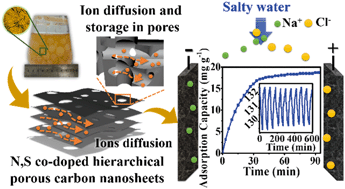Mycelial pellet-derived heteroatom-doped carbon nanosheets with a three-dimensional hierarchical porous structure for efficient capacitive deionization†
Abstract
Rational design of sustainable, cost-efficient and highly efficient deionization electrodes is crucial for the practical applications of capacitive deionization (CDI). Mycelial pellet-derived nitrogen and sulfur heteroatom co-doped three-dimensional (3D) carbon nanosheets (NSHPC) with a hierarchical porous structure have been facilely fabricated via a simple one-step strategy by utilizing sustainable mycelial pellets as a carbon source, glutaraldehyde as a crosslinking agent, zinc chloride as a pore forming agent, and thiourea as a heteroatom supplier. The obtained biomass-derived NSHPC nanosheets, with interconnected hierarchical macro-meso-micropores and a lamellar structure, exhibit outstanding CDI performance with an electrosorption capacity of 18.71 mg g−1 in 500 mg L−1 NaCl solution and a high reversibility (stable up to 10 cycles). The performance of NSHPC significantly surpasses that of the bulk mycelial pellet-derived carbon without activation and modification. The efficient CDI performance of NSHPC can be attributed to its unique features, including the 3D network structure formed by bundled nanosheets to provide multi-dimensional ion diffusion pathways and interlayer ion storage, the hierarchical pores to assist efficient ion diffusion and capture, the surface functional groups derived from mycelial pellets, and the hydrophilicity contributed by the heteroatom co-doping. The design of NSHPC nanosheets paves an avenue for developing efficient sustainable materials for CDI applications.



 Please wait while we load your content...
Please wait while we load your content...